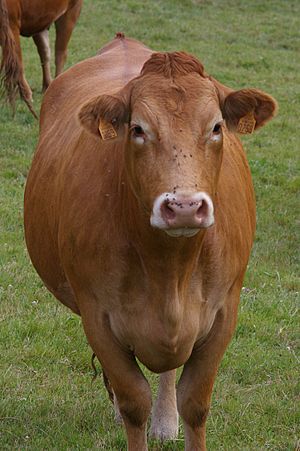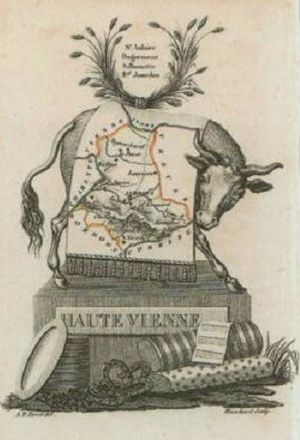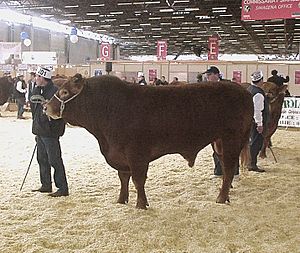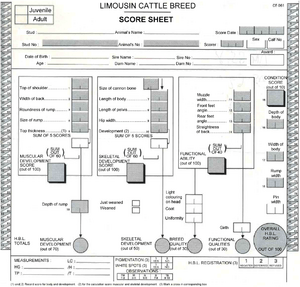Limousin cattle facts for kids

Limousine cow
|
|
| Conservation status |
|
|---|---|
| Other names | Limousine |
| Country of origin | France |
| Distribution | about 80 countries world-wide |
| Use |
|
| Traits | |
| Weight |
|
| Height |
|
| Coat | unicolour wheaten |
| Horn status | horned in both sexes |
|
|
The Limousin (pronounced "Lih-moo-zan"), also called Limousine in French, is a special type of beef cattle. These cows come from the Limousin and Marche regions of France. Long ago, they were mostly used as working animals to pull carts or plows. Today, they are raised for their high-quality meat.
A special record book, called a herd book, was started in France in 1886. This book helps keep track of the breed's family tree. In the 1900s, when machines started doing farm work, fewer Limousin cattle were needed. Their numbers went down. Some people even thought about combining them with other French cattle breeds.
But instead, a group of Limousin breeders formed an association. They focused on raising the cattle in open fields and tracking their growth. This helped the breed become popular again. Now, the Limousin is the second most common beef cattle breed in France. It is also famous around the world, raised in about 80 countries. Many of these countries have their own groups for Limousin breeders.
Contents
History of Limousin Cattle
Limousin cattle first developed in the Limousin region of France. This area has hilly land with rocky, acidic soil. The weather can change a lot, from hot to cold. These conditions helped the Limousin breed become very strong and tough. They developed thin but solid bones, which is unusual for cattle.
Scientists have studied the DNA of Limousin cattle. They found that Limousins are closely related to other cattle breeds from southwestern Europe. This suggests they might share a common ancestor. Some studies show a link between Limousin and Charolais cattle. Others point to connections with breeds like Gascon cattle, Aubrac cattle, and Blonde d'Aquitaine.
One historian believes the Limousin breed might have come from the blonde Garonne breed around 500 AD. The Garonne breed later joined the Blonde d'Aquitaine breed in 1962. Another grey cattle breed, also genetically close to Limousins, is thought to have arrived in France with the Visigoths around the same time.
Limousin cattle are known for being strong, muscular, and having fine bones. They are part of a group of working cattle found in southwestern Europe. This group includes many Spanish, Portuguese, and French breeds. They might have all come from cattle brought to the Iberian Peninsula long ago.
Limousin Cattle in the 1700s and 1800s
The first written records of Limousin cattle appeared in the late 1700s. At that time, they were famous for being excellent working animals. People in big French cities like Paris and Bordeaux wanted Limousin beef. A government official named Turgot helped this trade grow. In 1770, the police chief of Paris asked if he could get Limousin beef after Easter.
The cattle sent to cities were usually 8 to 10 years old. They were fattened up before being walked for 12 to 14 days to Paris or Bordeaux. In 1791, a farmer from Limoges, Jacques-Joseph Saint-Martin, noted how important Limousin cattle were. They came from many different areas, not just the Limousin region itself.
The market for Limousin cattle slowed down a bit in the early 1800s. But raising livestock still remained a very important activity in the region. Farmers used cows for all kinds of farm work.
At the start of the 1800s, some people thought Limousin cattle were not very good. They weighed only about 300 to 350 kg and were about 1.5 meters tall. People thought this was because of poor breeding and feeding. In farming contests, Limousin cattle often did not perform well. They were seen as working animals, but not well-shaped or good for milk.
A Brief Dip Before Rising Popularity
World War I slowed down the growth of the Limousin breed. This continued even after the herd book was reorganized in 1923. The number of registered animals grew slowly. It went from 600,000 in 1890 to 800,000 in 1940.
The Limousin breed almost disappeared in 1962. The French government planned to combine it with other "blonde and red" cattle breeds. These included the Garonne, Quercy, and Blonde des Pyrenees breeds. They would all form a new breed called Blonde Aquitaine. But Limousin breeders strongly disagreed. They fought to keep their breed separate, and they succeeded.
The Limousin breed started growing again in the 1960s. The number of Limousin cattle in France has increased a lot recently. It grew by 50% in just 15 years. Today, it is the second most common French beef breed. It is behind Charolais and ahead of Blonde d'Aquitaine. In 2014, there were about 2.69 million Limousin cattle in France. This included 1.09 million cows.
French Limousin Herd Book: What It Means
The purest Limousin cattle have ancestors that can all be traced back to "Full French" entries. These entries are in the official French Limousin herd book. In the USA and Canada, these are called Fullbloods. In Australia and New Zealand, they are called French Pure. In Europe, they are often just called purebred Limousin.
In France, there are two main types of Full French Herd Book entries. These are Pureblood (pur sang) and Pure Bred (race pure). The Pure Bred class follows rules set by the European Union (EU).
"Full French" is a term used by the French Limousin breeders' group. It means cattle meet these strict rules:
- They must be bred by active French members of the group. These breeders must test their animals on their farms. They also have selected animals tested by official experts.
- The cattle must be checked by independent experts. They must be certified as Full French according to the breed's official look and qualities.
- Some cattle are not allowed to be Full French. These include cattle imported into France. Also, cattle without horns (polled) are excluded. Cattle with certain "double muscling" genes from non-Limousin ancestors are also not allowed.
A less pure type of Limousin is "graded up." This means they are bred from a base animal over several generations. One parent in each generation must be a registered Limousin. In the USA, Canada, Australia, and New Zealand, a graded-up Limousin can be called "purebred" after three generations for females and four for males. These "purebreds" can then be registered in the herd books.
In Britain, grading up can only happen using Full French bulls. British graded-up females can be registered as Limousins after four generations from a non-Limousin cow. This is in the British Limousin Pedigree Register. This register is separate from the British Limousin Herd Book, which is only for animals with full Full French ancestors.
Limousin Cattle Characteristics
What Makes a Limousin Look Like a Limousin?
The official French Limousin breed standard describes what a Limousin cattle should look like. This standard was set on August 1, 1991.
Here are the main features of a Limousin:
- They are large beef cattle.
- Their coat color is a bright wheat color, not too dark. It's a bit lighter on their belly, inner thighs, between their legs, around the udder, and on the tip of their tail.
- They should not have any spots or dark skin. Their skin around the nose and mouth should be pink.
- They have a short head with a wide forehead and muzzle. The area around their eyes and muzzle is lighter.
- If they have horns, they are fine, curved forward, and slightly raised at the tip.
- They have a short neck and a broad, rounded chest.
- Their sides are round.
- Their pelvis is wide, especially at the back.
- Their front shoulders are well-muscled and wide.
- Their hindquarters are thick, deep, and rounded.
- Their horns and hooves are lighter in color.
- They have strong, correct legs.
- Their hide (skin) is fine and flexible.
Things that are not allowed in the French breed standard:
- Any dark spots on the muzzle, or black or white hairs anywhere on the coat. This is especially true in the ears, tail tip, or around the muzzle.
- Any white hairs anywhere on the body.
- A very low score for any of the breed standard points.
- A difficult or mean personality (calming them with medicine is not allowed).
- Any clear physical problems or deformities.
Different Limousin breed groups around the world use this standard. Some countries, like Belgium, follow it very closely. In the UK, breeders must follow their version of the standard to register animals.
In the USA, Canada, Australia, and New Zealand, their breed groups do not have a strict breed standard in their rules. Following a standard is optional. For example, in North America, to register a "Fullblood," the animal just needs to have "full French ancestry." In Australia and New Zealand, "French Pure" animals must have "100% Pure French genetics."
These countries also allow "graded up" animals to be registered as "purebreds." This means they don't have to meet a minimum amount of French Limousin content. This has led to some "purebreds" having less French Limousin in them. They might also look different from the original French standard. In these countries, breeders focus more on how well the animals perform and their genetic traits.
How French Breeders Improve Limousin Cattle
In France, breeders use a detailed system to select and improve Limousin cattle. This system started in the 1980s. It helps them predict which animals will pass on the best qualities.
For female cattle, the system mainly looks at how easily they give birth. It also checks the growth and body shape of their calves. The best females get special titles like "Reproductive Recognised" (RR) for the top 10%. The very best get "Reproductive Recommended" (RRE) for the top 1%. These titles help farmers find superior animals for breeding.
For male cattle (bulls), the selection process is more complex. The first step is at weaning (when calves stop drinking milk). Experts look at the calves' body shape and their parents' known qualities. The best young bulls get the title "Reproductive Hope" (Espoir).
Each year, about 700 young bulls are chosen. They go to a special evaluation station called Lanaud, near Limoges, France. They stay there from about seven months old until they are 13–14 months old. At Lanaud, they are all fed the same and live in the same conditions. This helps compare their performance. Any differences seen are mostly due to their genetics. This is important because genetics are passed on to their offspring.
After Lanaud, half of these young bulls get the title "Reproductive young" (RJ). Most of these bulls will be used for natural breeding. The very best ones are then tested further by checking their offspring. Like females, the best bulls get "Reproductive Recognised" (RR) or "Reproductive Recommended" (RRE) titles.
There are also local stations that help commercial farmers. These stations provide bulls with high potential for herds not registered in the main herd book.
The very best bulls go to special centers for artificial insemination (AI). Here, their semen is collected. AI allows a bull's good genes to be used by many more farmers. These bulls go through even stricter tests to ensure their genetic quality. Some go to another test station in Naves, Corrèze. There, they are checked for how well they turn food into growth and muscle.
The offspring of these top bulls are also evaluated. Male offspring go to a station in Pépieux, France. They are fed a special diet and then checked for growth and body shape. Their meat quality is also evaluated after slaughter. The best bulls from these tests get the "Young Beef Cattle" (JB) award. Female offspring go to a station in Moussour, Corrèze. They are checked for weight, growth, body shape, fertility, and milking ability. The bulls whose daughters show the best mothering qualities get the "Maternal Qualities" (QM) award.
These special titles (RR, RRE, JB, QM, etc.) are listed in sales catalogs. They help buyers choose Limousin cattle with the traits they want.
Why Limousins Are So Muscular
Limousin cattle have been popular for their meat quality and how well they grow for over 200 years. Since the 1990s, scientists have found out why. Limousins have a natural change in a gene called myostatin. This gene affects how muscles grow.
In all mammals, the myostatin gene makes a protein that controls muscle development. But in Limousins, a specific change in this gene makes the protein less effective. This leads to more muscle growth.
Limousins have a good amount of muscle, not too little and not too much. Some breeds, like Belgian Blue, have "double muscling" due to a different myostatin change. This makes them extremely muscular, but can cause problems. The Limousin's myostatin change (called F94L) gives them good muscle without the extreme issues.
Studies have shown that Limousins with two copies of the F94L gene have about 6% heavier meat carcasses. They also have 15% larger "eye muscle" areas (a key part of the ribeye steak). Their total meat weight can be 13% heavier. This increased meat comes with less fat, about 15% less fat within the muscle and 25% less total fat.
Comparing Limousins to Other Breeds
A long-term study in the USA compared Limousins to many other cattle breeds. It found that Limousin cattle were the most efficient at turning feed into meat that could be sold. They were also the fastest at this, even though they gained live weight slower than some other breeds.
This is because Limousins have a much higher percentage of their live weight as saleable meat. For example, Limousins had 46% saleable meat, while British breeds had about 34.9% and other European breeds had about 40.4%.
Limousins gained about 1.27 kg per day in live weight. British breeds gained 1.29 kg/day, and other European breeds gained 1.38 kg/day. But when it came to saleable meat gain, Limousins averaged 585 grams per day. The British breeds produced much less saleable meat (451 g/day) and more waste. They also ate about twice as much feed as Limousins. Other European breeds produced less saleable meat and ate about 25% more feed than Limousins.
So, even though Limousins might grow slower in overall weight, they are very good at turning food into valuable meat. This makes them very efficient for farmers.
Limousins generally have less fat within their muscles (marbling) and under their skin. Marbling is sometimes linked to better taste in meat. In some countries, Limousin's lean, tender meat is considered excellent. It is sold in special stores.
Farmers who want more marbling, but also the efficiency of Limousins, often use crossbreeding. They might breed Limousin bulls with British breed cows. Or they might use British breed bulls with Limousin cows. This helps them get a good balance of traits for different markets.
Crossbreeding with Limousins
Crossbreeding means breeding two different types of cattle together. This can make the offspring stronger and healthier. It also allows farmers to combine good traits from both parents. For example, using a Limousin bull with a British breed cow can combine the British cow's marbling with the Limousin's high meat yield.
Crossbred cows can produce up to 20% more calf weight. This is because they are often better at reproducing and being good mothers. Crossbred cows also tend to live longer.
The benefits of crossbreeding are strongest in the first generation. If these crossbred animals are then bred with animals similar to their parents, the benefits might lessen. But if they are bred with a new, different breed, the benefits can continue.
Two main types of Limousin crossbreds are Brahmousin and Lim-Flex.
Brahmousin Cattle
Brahmousin cattle are a mix of Brahman and Limousin breeds. They were first created in the USA in the late 1970s. The goal was to combine the best traits of both. This includes good reproduction, mothering skills, strong muscles, good growth, and the ability to live in different environments. Brahmousin are now found in the USA, Indonesia, El Salvador, and Australia.
The first Brahmousin cattle came from a Limousin mother and were then bred with Brahman cattle. Over time, a common mix became 5/8 Limousin and 3/8 Brahman. This mix is popular in the USA. In Australia, Brahmousin cattle can be between one-quarter and three-quarters of either parent breed. The goal is to combine Limousin's muscle and meat quality with Brahman's heat and parasite resistance. Brahmousin is now an officially recognized cattle breed in Australia.
Lim-Flex Cattle
Lim-Flex is not a purebred breed like Brahmousin. It is a special type of crossbred cattle. It is a mix of Limousin and either Angus or Red Angus cattle. This mix was developed in 2000 for North American farmers. They wanted hybrid bulls that would help them reach specific meat production goals.
To be called Lim-Flex, cattle must be between 25% and 75% Limousin. They must also be between 25% and 75% Angus or Red Angus. A very small amount (up to 1/8th) of other or unknown breeds is allowed. Lim-Flex offers many genetic choices. Farmers can choose animals with high muscle and efficiency (like Limousins) or those with more marbling and good mothering traits (like Angus). This helps them create cattle that fit different needs.
The Lim-Flex name is also used in Australia, New Zealand, and Canada. The rules for the percentages of each breed are similar in these countries.
Appearance of Limousin Cattle
Most Limousin cattle have a coat color that ranges from light wheat to a darker golden-red. Other colors, mainly black, have been developed. This happened by breeding Limousins with other cattle breeds. For example, Angus cattle have been used to introduce black color and the "polled" trait (meaning they don't have horns). These traits are now common in graded-up Limousins around the world.
Temperament of Limousin Cattle
Since the mid-1990s, Limousin breeders have worked hard to improve the temperament of their cattle. This means making them calmer and easier to handle. Temperament is a trait that can be passed down through genes. Scientists have developed ways to measure how docile (calm) an animal is. This helps breeders select for calmer cattle. As a result, Limousin cattle have become much calmer and easier to manage.
Limousin Cattle Around the World
Early Exports of Limousin Cattle
After the French Limousin Herd-Book was created in 1886, Limousins were sent to other countries. The first exports went to Brazil (1886), New Caledonia (1902), Uruguay (1910), Madagascar (1922), Argentina (1924), and Portugal (1929). However, only the herd in New Caledonia truly grew during this time.
It wasn't until after 1962, when Limousin breeding in France was reformed, that many cattle were exported worldwide. Limousins were brought back to Argentina (1966) and Brazil (1978). They were also imported to other European countries like Spain (1965), Italy (1968), the Netherlands (1969), Denmark (1970), and the United Kingdom (1971). When they arrived in the UK, it opened the door for Australia and New Zealand to import Limousin semen in 1972. Soon after, New Zealand allowed live Limousins from Ireland and the UK. The first "Full French" cattle came to Australia from New Zealand in 1975.
A very important step in the global spread of the Limousin breed happened in 1968. The first bull, named Prince Pompadour, was imported to Canada. His semen was then made available in the United States in 1969. In the early 1970s, more and more Limousin animals were imported to North America. Today, the North American Limousin Foundation is the largest group of Limousin breeders in the world.
Where Limousins Are Today
Limousins can adapt to many different environments. This has helped them become successful around the world. In most cases, Limousin bulls or their semen are now imported to improve local Limousin herds.
Today, the breed is found in about 70 countries. They live in places from Finland in the north to South Africa in the south. Many of these countries have their own Limousin breeders' associations. Twenty-nine of these groups are members of the International Limousin Council (ILC). The ILC was started in Limoges, France, in 1973. In 1989, EUROLIM was formed to connect all the European Limousin herd books.
Limousins in different countries are bred for different goals. There isn't a lot of genetic exchange between countries. This means each country's Limousin population is becoming a bit different. However, some genes from other countries do help balance this. For example, a study of over 2.4 million Limousin records from five European countries showed some gene flow from France to the UK and Denmark. But there was very little exchange between other European countries, especially after 2000.
However, the genetic contribution of North American Limousins to European countries has grown since the late 1990s. This is because they are used in breeding programs to introduce the "polled" gene (no horns).
Today, you can find Limousin genetics from all over the world. Many companies specialize in exporting and importing semen for artificial insemination programs. This makes it easier for farmers everywhere to access Limousin genetics.
Images for kids
See also
 In Spanish: Limousin (raza bovina) para niños
In Spanish: Limousin (raza bovina) para niños








